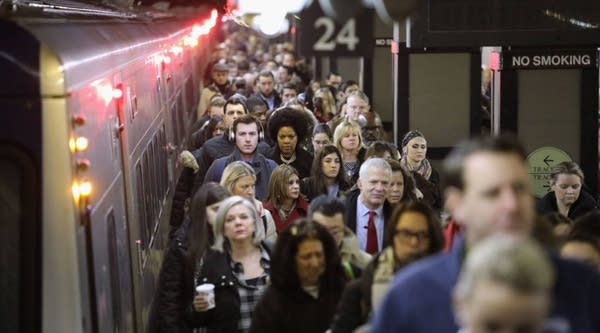Do people even work 9-to-5 anymore?
Or is it just a phrase we use?

This is just one of the stories from our “I’ve Always Wondered” series, where we tackle all of your questions about the world of business, no matter how big or small. Ever wondered if recycling is worth it? Or how store brands stack up against name brands? What do you wonder? Let us know below.
Listener Krysta Bea Jackson from Reno, Nevada asked Marketplace this question:
How come day/office jobs are called a “9-to-5” when in reality everyone works 8 a.m. to 5 p.m.? Is it some holdover of a bygone era?
While not everyone goes to work at the same time, most of the U.S. labor forces arrives in the office somewhere between 7 a.m. and 9 a.m.
In 2014, FiveThirtyEight took a look at the Census data and calculated the median time Americans begin their workday in each metro area. Here is a sampling of what they found:
In New York, median workday starts at 8:24 a.m.
In Los Angeles, at 8:05 a.m.
In San Francisco, at 8:21 a.m.
In Washington, D.C., at 8:07 a.m.
In Houston, at 7:45 a.m.
Just as not all workers arrive to work at the exact same time, they don’t leave at the same time either. Some leave at 5 p.m. Some leave at 6 p.m. Some leave even later. It all depends on their employer. Some companies work in a half-hour paid lunch break into the eight-hour workday. Others have their workers take an hour-long unpaid lunch. The latter is so common now that people have begun to wonder if 9-to-6 is the new normal.
“Nine to six isn’t unusual, and neither is 8-to-5, and lots of other variations,” Alison Green, the manager behind the popular Ask a Manager blog and a regular contributor to Marketplace Weekend, wrote in 2015. “The thinking behind those is often that they include an hour for lunch — so you’re still working eight hours, but the finish time is nine hours after your start time because of lunch. I question this reasoning, because tons of people with this schedule don’t actually take a full hour for lunch, but that’s where it came from.”
The 9-to-5 schedule — or something close to it — is still very much in demand, both because it can be seen as a status symbol often associated with white collar workers and because it holds a promise of consistency.
Back in 2015, researchers surveyed 7,000 online job seekers about their preferred work schedule. They found that people were willing to take an 8 percent cut in pay to work from home and 20 percent less to get a regular 9-to-5 weekday schedule.
The 40-hour work week is barely a century old. Workers that were given the new schedule fought hard to keep it even as the implementation of the 9-to-5 workday has proven to be difficult on some metro areas. The rush hour and the things that come along with it — the overcrowded trains and busses, the traffic jams — are just some of the negative effects.
Since as early as 1926, New York City has been trying to convince employers in the city to scatter their schedules. Apparently back then, the million and a half workers commuting to work in the morning were a burden on the local transportation system. According to the New York Times, employers weren’t big fans of the stagger plan and fought about who — if anyone — should change their schedules.
And so while our work days tend to start as early as 8 a.m. and end at about 6 p.m., they are still pretty much the standard working hours that have come to be commonly referred to as 9-to-5.













